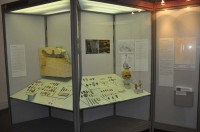The Palaeolithic and Mesolithic
250,000 - 6,500 B.C.
During the Paleolithic (250,000 - 9,500 BC), the hilly and mountainous areas of Vicenza area were frequented by groups of hunter-gatherers who occupied caves and rock shelters on a non-permanent basis for varying periods. The artifacts were made of flint and bone, as well as perishable materials such as wood, leather, and plant fibers.
In Vicenza area, the caves on the eastern slopes of the Berici Hills hosted the most important settlements.
The oldest hearths in Europe (250,000–200,000 years ago) are documented in San Bernardino Cave (Mossano). The flint artifacts (thin, sharp Levallois flakes, points, and scrapers) date back to the Mousterian (Middle Paleolithic) and Neanderthal man.
The stratigraphic sequence of Broion Cave (Longare), which contains flint and bone tools as well as ornamental objects (drilled deer teeth), documents the evolution of the environment during the last glacial period (Wurmian, 80,000–10,000 years ago). The cave was frequented by Neanderthals and by modern humans.
The final phase of the Upper Paleolithic is documented in Paina (Mossano) and Trene (Nanto) caves and in the open-air sites of Fiorentini (Tonezza) and Val Lastari (Asiago Plateau).
Covoloni del Broion cave, San Quirico shelter (Valdagno), and Cima Dodici (Asiago Plateau) were frequented during the Mesolithic (9,500–6,500 BC), the transitional period between the Paleolithic and Neolithic periods. During this period, the stone industry specialized in the production of microliths to arm javelins and arrows used in hunting small and medium-sized mammals.
Image Gallery
 |

